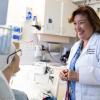
Beyond “Back to Sleep”: California SIDS Program Takes Multifaceted Approach to Reducing Incidence, Impact
The death of an infant is devastating. When the cause is unexplained, unanswered questions and self-blame can compound a family’s grief – as can insensitive or busy first responders and health care providers. The California SIDS Program (CA SIDS Program), funded by a federal Title V Maternal and Child Health Block Grant through the California Department of Public Health’s Maternal, Child and Adolescent Health Program, aims to reduce the incidence and impact of SIDS by educating families and caregivers on how to reduce risk, and by training first responders and health care providers to provide more sensitive help and support.
A Multifaceted Approach to SIDS
Sudden infant death syndrome (SIDS) is the sudden, unexplained death during sleep of an infant under age 1. Historically known as “crib death,” it remains the leading cause of death for infants between the ages of 1 month and 1 year in the US. The CA SIDS Program was established in 1989 after Governor George Deukmejian signed the first of four SIDS bills into law.
The CA SIDS Program takes a multifaceted approach to its mission, says Abbey Alkon, professor at UC San Francisco School of Nursing, who was recently named program contract director. The program collects and provides data to the state, develops educational materials and training curricula, and provides resources for the public and professionals. In addition, the program has a toll-free SIDS telephone line and provides technical assistance and grief support along with regional trainings and an annual statewide conference, open to everyone from public health nurses, first responders and coroners to families.
Alkon brings decades of experience as a leader in child health and safety to her role. She has served as director of the California Childcare Health Program (CCHP) – a program of the UCSF School of Nursing’s Department of Family Health Care Nursing – since 2001. She’s worked with national and state agencies, private groups and health care organizations on education and training projects promoting the health and welfare of children; both she and UCSF School of Nursing have a reputation as experts on health and safety issues for children.
Promoting Safe Sleep
 Abbey Alkon “It’s never going to be zero, but we can reduce the risk of SIDS,” says Alkon. Thanks to the national, state and local “Back to Sleep” campaign, many people are aware of the importance of placing an infant on his or her back to sleep, and SIDS rates have declined since the campaign was launched in 1994. Known today as “Safe to Sleep,” the campaign provides further recommendations for creating a safe sleep environment, which is one of the key messages the CA SIDS Program promotes. Recommendations include making sure the sleep surface is firm and that there are no soft objects in the baby’s sleep area, avoiding the use of alcohol or smoking around the baby, providing a pacifier at bed- and naptime and not sharing a bed with the baby.
Abbey Alkon “It’s never going to be zero, but we can reduce the risk of SIDS,” says Alkon. Thanks to the national, state and local “Back to Sleep” campaign, many people are aware of the importance of placing an infant on his or her back to sleep, and SIDS rates have declined since the campaign was launched in 1994. Known today as “Safe to Sleep,” the campaign provides further recommendations for creating a safe sleep environment, which is one of the key messages the CA SIDS Program promotes. Recommendations include making sure the sleep surface is firm and that there are no soft objects in the baby’s sleep area, avoiding the use of alcohol or smoking around the baby, providing a pacifier at bed- and naptime and not sharing a bed with the baby.
This last recommendation has created new controversies, says Alkon, because breastfeeding advocates sometimes recommend bed sharing as a way to increase breastfeeding rates, but bed sharing is a known risk factor for SIDS. “We absolutely promote breastfeeding,” she says, “because it can reduce the risk of SIDS, but babies should be put to sleep in their own cribs on their backs after they are breastfed.” It’s even better if the baby is in the same room as the mother, but not on the same surface, says Bobbie Rose, a public health nurse with the CCHP and a CA SIDS Program nurse educator.
Targeting Specific Audiences for Maximum Impact
Getting messages about safe sleep out to California’s large, diverse population is a primary goal for the CA SIDS Program, says Rose, and the program conducts outreach and offers resources in a variety of languages and at different literacy levels. The CA SIDS Program also targets specific groups with the potential to make an impact in the state. Child care providers, for example, are an important audience. The program works in conjunction with regional SIDS councils, resource and referral agencies and other organizations to educate child care providers on safe sleep practices and to create policies to promote those practices.
 The CA SIDS Program offers risk-reduction resources for a variety of audiences. Hospitals are another target audience because pediatric and postpartum nurses are ideally placed to reinforce risk-reduction practices among new parents. The Southern California Regional SIDS Council members are working on a pilot project to train nurses and parents in SIDS risk reduction when the infant is in the hospital, and if this project is successful, the CA SIDS Program will work with other hospitals to replicate it across the state, says Alkon.
The CA SIDS Program offers risk-reduction resources for a variety of audiences. Hospitals are another target audience because pediatric and postpartum nurses are ideally placed to reinforce risk-reduction practices among new parents. The Southern California Regional SIDS Council members are working on a pilot project to train nurses and parents in SIDS risk reduction when the infant is in the hospital, and if this project is successful, the CA SIDS Program will work with other hospitals to replicate it across the state, says Alkon.
Helping Families Affected by SIDS
Yet risk reduction is only part of the job. State laws require that a public health nurse or social worker contact families or care providers within three days of the coroner notifying the county of a presumed SIDS death. The CA SIDS Program trains these individuals – known as SIDS coordinators – to help families in the aftermath of a death and to serve as liaison between the county and the family. It is one of the most important things the program does, says Alkon, because SIDS coordinators are often the primary resource for affected families, doing everything from providing grief counseling referrals to helping families arrange for burial.
Supporting families affected by SIDS is an essential part of the CA SIDS Program’s mission because many parents and caregivers don’t understand that even when they do everything right, babies can still die. Recent research suggests that there’s a biological component to SIDS. For example, reduced production of the neurotransmitter serotonin or small defects in the medulla oblongata (the area of the brain that regulates important involuntary functions like respiration) have been linked with increased risk.
“We never say SIDS can be prevented,” says Rose. That’s an important message because of the stigma and guilt that can affect families, and the program provides SIDS training for first responders twice a year. Alkon says, “There’s sensitivity in coming into a family’s home when a baby has just died.” And it’s perhaps understandable for first responders to instinctively focus on “Who did it?” instead of “How can we help you?”
That’s why promoting sensitivity and compassion is a top priority for the CA SIDS Program. For even with the success of risk-reduction efforts, babies still die of SIDS. Alkon hopes to reduce the numbers who do die, but she knows that the need to help grieving parents and caregivers through the loss of an infant remains.



